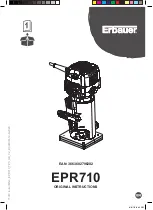
20
DEPTH OF CUT
See Figures 20 - 21.
Depth of cut is important because it affects the rate of feed
that, in turn, affects the quality of the cut and the possibility
of damage to the tool’s motor and bit.
A deep cut requires a slower feed than a shallow one. A cut
that is too deep will slow the feed so that the bit is scraping
rather than cutting. A too deep cut can cause smaller bits
to be broken off. Bits that are 1/16 in. in diameter are easily
broken off when subjected to too much side thrust. A large
enough bit is not likely to break, but attempting a cut that
is too deep may result in a rough cut, and it may be difficult
to guide and control the bit as desired. It is recommended
that you do not exceed 1/8 in. depth of cut in a single pass,
regardless of the bit size or the softness or condition of the
workpiece.
To make deeper cuts, make as many successive passes as
needed, lowering the bit 1/8 in. for each new pass. To save
time, perform all the cutting necessary at one depth setting
before lowering the bit for the next pass. This will insure a
uniform depth when you complete the final pass.
NOTE:
Do not remove more than 1/8 in. in a single pass.
Excessive depth of cut can result in loss of control and the
possibility of serious personal injury.
OPERATION
DEPTH
OF CUT
WIDTH OF CUT
1ST
PASS
2ND
PASS
1ST
PASS
2ND
PASS
Fig. 20
Fig. 22
Fig. 21
ADJUSTING LOCK LEVER TENSION ON THE
FIXED BASE AND PLUNGE BASE ROUTER
See Figure 22.
Over time and with repeated use, the lock lever may become
loose. When this occurs, tighten the stop nut slightly. The
elastic stop nut should be loose enough so that there is some
play in the lock lever when it is in the open position.
NOTE:
Do not over tighten the elastic stop nut. The lock lever
should clamp tightly to secure the motor housing.
CAUTION:
Make sure the motor housing does not move
up or down when clamped. If motor is not
securely clamped in base, adjustments will not
be accurate.
LOCK LEVER
TO
TIGHTEN
STOP NUT
REAR VIEW
ADJUSTMENTS
WARNING:
Follow the provided proper instructions when
mounting router to a routing table. Failure to use
router tables with appropriate safety features could
result in serious personal injury. Use router tables
that are UL classified and identified suitable for use
with the specific router model.
ROUTER TABLE ATTACHMENT
See Figure 23.
When attaching the router to a routing table, remove the
subbase, and use the router table attachment screws pro-
vided with the router. Use these screws to replace the sub-
base screws shown in figure 23.





































